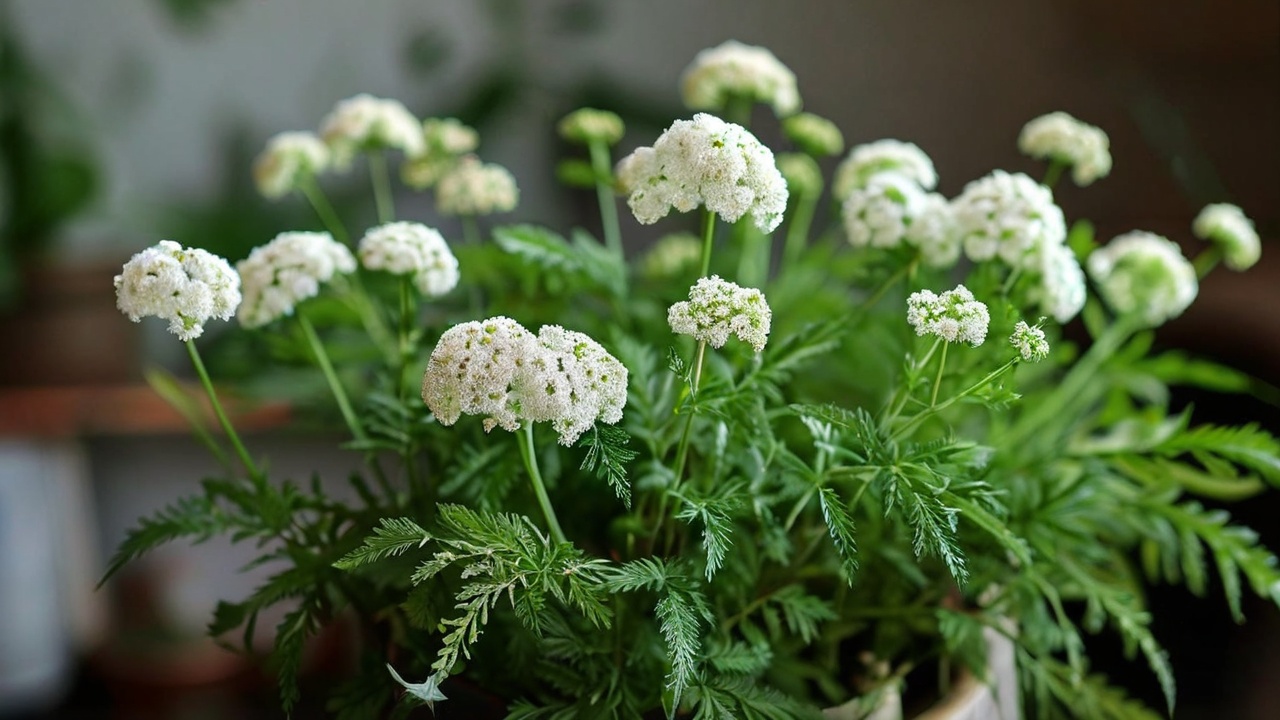Yarrow (Achillea millefolium) is a versatile and hardy herbaceous perennial plant native to temperate regions of the Northern Hemisphere, including North America, Europe, and Asia. It belongs to the Asteraceae (daisy) family and is well-known for its feathery, fern-like leaves and clusters of small, aromatic flowers, which range in color from white to pink, yellow, or red. The plant typically grows 1 to 3 feet tall and can thrive in a variety of environments, including meadows, grasslands, and open woodlands
- Leaves: Yarrow’s finely divided, aromatic leaves have a feathery appearance, and they are typically dark green.
- Flowers: The flowers form in dense, flat-topped clusters (known as corymbs), blooming from late spring to fall. The small, composite flowers are attractive to pollinators such as bees and butterflies.
- Height: The plant grows between 1 and 3 feet tall, depending on the variety and growing conditions.
Ecological Benefits:
Yarrow is often grown in gardens for its aesthetic appeal, as well as its role in supporting pollinators. The plant is drought-tolerant, thrives in poor soils, and helps to improve the soil by adding organic matter.
Traditional Uses:
Yarrow has a rich history of medicinal use dating back to ancient times. The name “Achillea” is derived from the Greek hero Achilles, who, according to legend, used the plant to treat wounds on the battlefield. Historically, yarrow was used to stop bleeding, reduce inflammation, and alleviate pain.
Modern Applications:
In modern herbal medicine, yarrow is still used for its potential health benefits, including:
- Anti-inflammatory properties: Used in salves and tinctures to reduce swelling and heal wounds.
- Digestive aid: Used as a tea to support digestion and alleviate bloating or discomfort.
- Menstrual support: Sometimes used to help regulate the menstrual cycle and reduce cramping.
In addition to its medicinal uses, yarrow is popular in landscaping for its low-maintenance care and ability to withstand dry, poor soil conditions.
Growing Conditions:
- Sunlight: Prefers full sun but tolerates partial shade.
- Soil: Grows best in well-drained soil, though it can adapt to various soil types.
- Watering: Drought-tolerant once established; water sparingly.
- Propagation: Can be propagated from seeds, division, or cuttings.
1. Medicinal Uses
Yarrow has a long history in herbal medicine for its potential healing properties:
- Wound healing: Yarrow is often called “soldier’s woundwort” because it has been used to stop bleeding from cuts and wounds. The leaves can be crushed and applied as a poultice to wounds to promote healing.
- Anti-inflammatory: Yarrow can help reduce inflammation and is used to treat bruises, sprains, and other inflammatory conditions.
- Digestive aid: Yarrow tea is used to stimulate digestion, alleviate stomach cramps, and help with indigestion.
- Fever reduction: Yarrow induces sweating, helping to lower fevers naturally.
- Respiratory support: It can be used to treat colds, coughs, and flu symptoms by clearing congestion and aiding the respiratory system.
- Menstrual health: Yarrow is sometimes used to regulate menstrual cycles and relieve menstrual cramps.
2. Culinary Uses
- Edible leaves and flowers: Young yarrow leaves can be added to salads or cooked as a vegetable. They have a slightly bitter, earthy flavor. The flowers can be used to garnish dishes.
- Herbal tea: Yarrow flowers and leaves can be brewed into a tea for a range of benefits, including digestive support and fever reduction.
3. Gardening Uses
- Pollinator attractor: Yarrow attracts beneficial insects such as bees and butterflies, making it a great addition to pollinator-friendly gardens.
- Companion planting: It can be used in gardens to improve soil quality and repel harmful insects.
- Ground cover: Yarrow spreads easily, making it a useful ground cover plant in xeriscaping or for erosion control.
4. Cosmetic Uses
- Skincare: Yarrow’s astringent and anti-inflammatory properties make it useful in skincare products, including lotions and balms, to soothe irritated or sensitive skin.
5. Other Uses
- Aromatic herb: Dried yarrow leaves and flowers are used in potpourri or sachets for their aromatic qualities.
- Dyeing: Yarrow can be used to produce natural dyes in shades of yellow and green.
